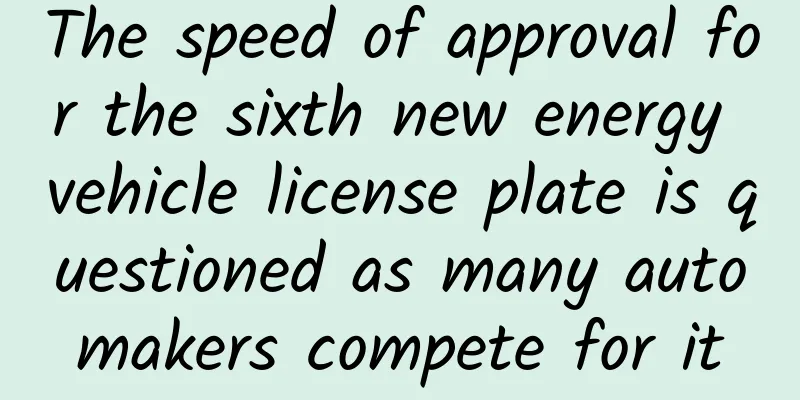The speed of approval for the sixth new energy vehicle license plate is questioned as many automakers compete for it

|
Fighting for the sixth new energy vehicle license: strict entry and loose exit and overcapacity At present, there are more than 20 new energy vehicle companies waiting for review, or whose prototypes are undergoing or have passed the test. "There are so many prototypes waiting for testing that the testing institutes in Tianjin and Chongqing are overwhelmed. The local government is also very enthusiastic, but do we really need so many new energy vehicle companies?" an expert asked in an interview with a reporter from 21st Century Business Herald on November 27. On November 21, a "little-known" electric car company, Jiangsu Min'an Electric Vehicle Co., Ltd., obtained the qualification to produce new energy vehicles. This is the fifth new energy vehicle production license issued by the National Development and Reform Commission, following BAIC New Energy in March, Changjiang EV in May, Qiantu Motors in October, and Chery New Energy on November 2 this year. So far, the rapid approval speed and fierce competition for new energy vehicle qualifications have attracted attention in the industry, and the sixth qualification winner will surface in the near future. According to an expert who requested anonymity, electric vehicle companies such as Zhejiang Wanxiang, Jiangling New Energy, NEVS, and Zhidou are all pressing ahead with qualification review. "Some of their prototypes are being tested, and some have already been reviewed by experts. If nothing unexpected happens, the sixth new energy vehicle production license will be issued among them." It is understood that there are more than 20 new energy vehicle companies waiting for review, or whose prototypes are undergoing or have passed the test. "There are so many prototypes waiting for testing that the testing institutes in Tianjin and Chongqing are overwhelmed. The local government is also very enthusiastic, but do we really need so many new energy vehicle companies?" The above expert asked in an interview with a reporter from 21st Century Business Herald on November 27. Obviously, referring to the current situation of qualified enterprises, the country has "relaxed" the entry threshold for new energy vehicles. "For the qualification of new energy vehicle production, the country has set rules, and as long as enterprises strictly follow the rules, the country still encourages enterprises to develop new energy vehicles." The above expert told reporters. However, considering the current situation of China's new energy vehicle development, whether domestic enterprises are needed and whether the cars produced by these enterprises can meet the market requirements have become the focus of market attention. At the beginning of this year, relevant national departments began to jointly investigate the phenomenon of new energy vehicle subsidy fraud and announced a list of fraudulent subsidies in September. However, many problems surrounding new energy vehicles still exist. Industry insiders believe that market supervision needs to be strengthened on the issue of qualifications to prevent similar fraudulent subsidy incidents from happening again. Competing for new energy qualifications As the first threshold to enter the new energy vehicle field, obtaining qualifications is particularly important for enterprises. With the increase in the number of new energy vehicle qualifications, the number of qualifications left for many car companies is decreasing, and the competition for qualifications is becoming more intense. Industry insiders analyzed that, on the one hand, traditional automobile companies are closely planning for qualifications, while on the other hand, new entrants such as LeTV, CHJ Automotive, and Harmony Futeng are also accelerating their development in order to obtain qualifications. Therefore, while strictly reviewing new entrants, the country is considering whether to introduce qualifications for low-speed electric vehicles. However, it is not so easy for companies to obtain qualifications at present, and the failure of Jiangsu Aoxin's qualification application has also sounded the alarm for many companies. It is understood that Jiangsu Aoxin and Wanxiang Group applied for new energy vehicle production qualifications relatively early, but have not yet obtained the qualifications. Although Aoxin's prototype vehicle passed the inspection, on October 20, the NDRC's online approval platform showed the approval status of Jiangsu Aoxin New Energy Co., Ltd.'s investment in a project to produce 20,000 carbon fiber lightweight pure electric passenger vehicles annually as "failed." Wanxiang Group is also in the same boat. As early as 2012, Wanxiang Group invested 100 million US dollars to establish a joint venture with Smith, an American electric vehicle manufacturer, mainly producing electric commercial vehicles. Although Wanxiang Group obtained the production qualification of new energy commercial vehicles at the end of May this year, it has not yet obtained the production qualification of new energy passenger vehicles. Therefore, the outside world has speculated that the sixth qualification winner is likely to be Jiangling New Energy and NEVS New Energy. It is reported that the traditional car companies that have obtained new energy vehicles include BAIC New Energy and Chery New Energy, and Jiangling Motors has made new energy the strategic direction of the group for the next ten years. Its prototype has passed the inspection and is waiting for the review of the National Development and Reform Commission. At the same time, the NEVS Tianjin project was listed as a key project to be promoted in 2016 by the Tianjin Development and Reform Commission, and NEVS's Tianjin subsidiary, Guoneng New Energy Automobile Co., Ltd., is likely to become the qualified recipient. New energy access is "strict entry and lenient exit" Based on previous national automobile-related policy-making experience, the requirements for industry development are “strict entry and loose exit”, and the setting of new energy vehicle production qualifications is no exception. On August 12 this year, the Ministry of Industry and Information Technology of China announced the "Regulations on Access Management of New Energy Vehicle Manufacturers and Products (Draft for Comments)", which significantly raised the entry threshold for new energy vehicles. The entry conditions include a total of 17 clauses, which are detailed from the aspects of design and development, production capacity, product production consistency capacity, after-sales and product safety assurance capacity. Among them, 8 are "veto clauses". As long as more than 2 "veto clauses" are not met, the enterprise does not meet the "access conditions". The "veto clauses" mainly include new energy vehicle development and manufacturing technology, vehicle control system, etc. At the same time, the qualification is not a lifetime system. Article 25 of the draft opinion points out that manufacturers of complete vehicles, modified buses, and special-purpose vehicles that have obtained the "Announcement" qualification for the production of new energy vehicles before the implementation of these regulations shall be transformed and submit a review plan that meets these regulations within 6 months from the date of implementation of these regulations, and complete the review within 24 months. If the review is not completed within the deadline, the production and sales of relevant new energy vehicle products shall be suspended. It can be seen that the qualification entry threshold is relatively strict. Wang Binggang, leader of the National 863 Plan Energy Conservation and New Energy Vehicle Major Project Supervision and Consulting Expert Group, told reporters: "Compared with foreign countries, the entry threshold for new energy vehicles in China is relatively high, but this does not guarantee that the development of new energy vehicles will be smooth sailing. On the contrary, the state needs to pay more attention to market supervision and impose penalties on companies that have obtained qualifications but whose products do not meet the standards to ensure the healthy development of the new energy vehicle market." Although the qualification entry threshold has been raised, there are still many companies applying for qualifications. Currently, five companies have been confirmed to have obtained new energy vehicle production qualifications, including traditional independent brand car companies, new car companies and Sino-foreign joint ventures. However, not all companies planning to produce new energy vehicles are pinning their hopes on obtaining the qualification. Changan executives have revealed that Changan New Energy Company does not need this qualification because Changan Automobile itself has the production qualification. At the same time, new car companies such as Singularity Motors and NIO do not need qualifications, and their electric car production is mainly done by OEM. "The first and second batches of Singularity Motors' new cars will be produced by OEM." On November 9, at the Singularity Motors press conference, Singularity Motors CEO Shen Haiyin told reporters. Previously, the China Association of Automobile Manufacturers mentioned that ten new electric vehicle companies would be enough, but according to the current trend, there is no upper limit to this number. "There are about 40 car companies in China that need qualifications. If there are only 10, it is obviously not enough to meet the development needs. More new energy car companies will force traditional car companies to enter, thereby promoting the entire industry to achieve fuel emission targets." Cai Wei, founder and chief technology officer of Jingjin Electric, said in an interview with a reporter from 21st Century Business Herald. 2020 is the first time node for achieving the new energy vehicle goal, leaving the country less than 4 years to achieve the fuel emission target. It is reported that in 2015, the Ministry of Industry and Information Technology disclosed the 10-year strategic goal of the development of energy-saving and new energy vehicle industry in "Made in China 2025", among which by 2020, the annual sales of self-owned brand pure electric and plug-in new energy vehicles will exceed 1 million. However, affected by the subsidy fraud incident this year, the sales volume of new energy vehicles has fluctuated to a certain extent. According to the data from the China Passenger Car Association, by October this year, the sales volume of new energy vehicles in China was 40,700 units, down 1% year-on-year and 2% month-on-month respectively. September and October should have been the peak sales season, but the sales growth rate of new energy vehicles has dropped significantly. Some analysts say that this year's new energy vehicle sales are expected to be between 400,000 and 450,000 units, which is still nearly 600,000 units away from 1 million units. At the same time, new subsidy policies have not yet been introduced, and whether the qualification of new energy vehicle production can become a new driving force for the growth of new energy vehicles remains in doubt. "With the decline of new energy vehicle subsidy policies, new companies are facing more intense competition in many aspects, from funds to products. Whether they can achieve the 2020 target still needs to wait for the test of the market," said Wang Binggang. Preventing overcapacity in new energy There is no doubt that the subsidy fraud incident has a relatively large impact on the new energy market. Faced with the temptation of subsidies of several million or even tens of millions, many car companies have taken risks, leading to chaos in the industry. The new subsidy policy has not yet been implemented, and companies that have obtained new energy vehicle qualifications have once again attracted attention. How to prevent similar subsidy fraud incidents from happening again and strengthen market supervision of companies that have obtained new energy vehicle production qualifications have become issues that need to be urgently addressed in future policy formulation. At present, the domestic new energy market is still a policy-driven market. How to transition to a regulation-driven market has become an important part of the future development of the new energy market. Regarding the issue of new energy qualification policy, Fu Yuwu, chairman of the China Society of Automotive Engineers, told reporters: "Compared with the past, the government's management ideas and management concepts have not changed much. What we need to strengthen is the management after approval." In fact, the subsidy policy has not prompted companies to produce new energy vehicles with market competitiveness. "It is recommended that the subsidy policy in the future gradually transition from subsidies to tax cuts to encourage high-quality products to stand out in the market competition. In terms of qualifications, we advocate 'loose entry and strict exit', set supervision and testing regulations based on advanced foreign experience, and increase the cost of violations for companies." Cai Wei suggested that if the future fuel emission targets are to be achieved, the government needs to make good regulations and leave the rest to the market. It is worth noting that one of the issues that must be faced in the development of new energy vehicles is production capacity. By the end of 2015, 37 major automobile companies, which accounted for more than 98% of the annual automobile production, had formed a complete vehicle production capacity of 31.22 million vehicles, of which passenger vehicle production capacity was 25.75 million vehicles, with a capacity utilization rate of 81%; commercial vehicle production capacity was 5.47 million vehicles, with a capacity utilization rate of only 52%, which means that my country's automobile industry has already seen structural overcapacity. Obviously, the development of new energy vehicles needs to prevent the risk of overcapacity of traditional vehicles. "The domestic market does not need so many new energy vehicle manufacturers. The current investment behavior is too impulsive, and the investment impulse comes from finding economic growth points. Excessive investment is bound to form overcapacity. The duplicate construction caused by overcapacity is vicious competition, which is not conducive to the transformation and upgrading of the industry. The government needs to regulate this aspect." Fu Yuwu finally said. As a winner of Toutiao's Qingyun Plan and Baijiahao's Bai+ Plan, the 2019 Baidu Digital Author of the Year, the Baijiahao's Most Popular Author in the Technology Field, the 2019 Sogou Technology and Culture Author, and the 2021 Baijiahao Quarterly Influential Creator, he has won many awards, including the 2013 Sohu Best Industry Media Person, the 2015 China New Media Entrepreneurship Competition Beijing Third Place, the 2015 Guangmang Experience Award, the 2015 China New Media Entrepreneurship Competition Finals Third Place, and the 2018 Baidu Dynamic Annual Powerful Celebrity. |
<<: UK provides £390 million in funding for autonomous/electric vehicle projects
Recommend
3 ways and 1 case study for new operators to quickly develop data thinking
There are many communication problems within the ...
The call of the knot of mountains! What is the Pamir Plateau?
The westernmost point of China Snow-capped mounta...
American warriors used "magic stones" to fight, which were as lethal as iron weapons
Reviewer: Ma Zhifei Geological science writer, se...
How to improve user retention rate? Share 6 rules!
Retention rate is the most important criterion fo...
ChatGPT is popular. If you want to avoid being replaced by AI, you need to have the ability of "meta-learning"
A while ago, ChatGPT became popular all over the ...
A complete operation and promotion plan for an App!
1. Concept of App operation and promotion Quoting...
Automobiles and home appliances are the backbone of China's industry
It is not the software industry, nor high-tech. O...
From the operational routines of Huawei, Xiaomi, OPPO, and vivo, let’s see how to promote product launches!
The smartphone market has entered a stage of fier...
Want to design UI for iPhone X? Here are 11 design tips
When designing UI for iPhone X, the completely di...
How to make African mercenary sign advertising?
The African mercenary placard advertisement was s...
Revealed: The 10 most popular programming languages and their creators
The creators of these programming languages are...
Is South Korea's room-temperature superconductivity research result true? An article to understand where the replication experiment is stuck
On July 22, a South Korean research team uploaded...
Which should you choose, TLC or MLC? How to buy a solid-state drive
Before deciding to upgrade your SSD, you should fi...
A seasonal delicacy that you cannot miss, a spring in one bite
Review expert: Li Guangwang, Director of the Natu...
Decisive Collection丨Summary of arrangements for the National Day holiday in some Android app markets
The National Day and Mid-Autumn Festival are appr...









